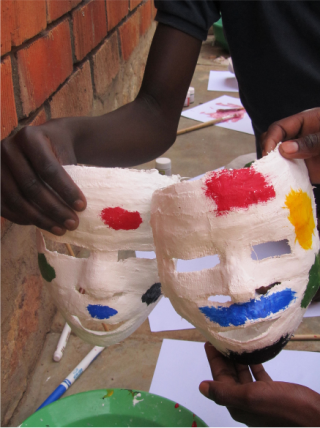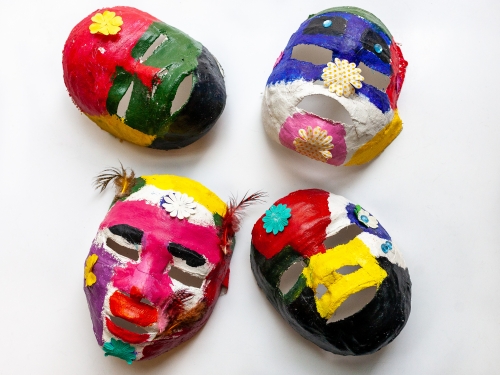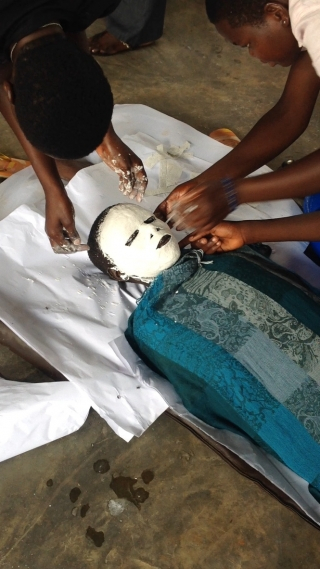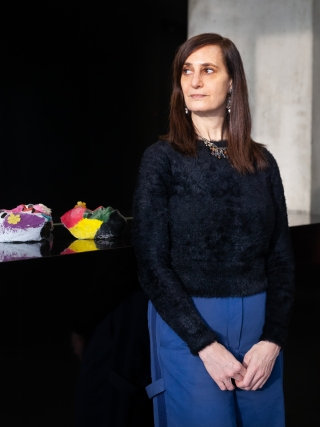Future Ready is a long-read research series published by Research and Innovation. Field photography by Myriam Denov. Portraits by Karene-Isabelle Jean-Baptiste, winner of the inaugural Photojournalism Diversity Grant from La Presse in 2021.
Green was for the grass they ran through, children born in the bush fleeing government soldiers. Blue for the bodies of water, immense to a child’s eyes, they crossed on their parents’ backs and shoulders. Yellow for the sun that meant staying in place, before the dark that meant running. And red for the blood. “These red colors represent the blood that was shed from the people who got injured from gunshots, cut by pangas [broad knives],” a boy wrote.
He was describing a mask he made and painted as part of an arts-based research project in northern Uganda. The project was the result of a partnership between local community organization Watye Ki Gen (WE HAVE HOPE) and Myriam Denov, McGill’s Canada Research Chair in Children, Families and Armed Conflict (Tier 1). The initiative, funded by Denov’s 2014 Trudeau Foundation Fellowship, involved seventy-nine children and youth who had been born into captivity in the Lord’s Resistance Army (LRA).
From 1986 to 2007, the LRA, led by Joseph Kony, fought a guerilla war against government forces and inflicted untold suffering on the civilian population. The group abducted an estimated 60,000 to 80,000 children into its insurgency, forcing them to kill or be killed. Due to the LRA’s policy of forced marriage, girls kidnapped from their villages were married off to commanders. In post-conflict present-day northern Uganda, thousands of the children born under these conditions and from sexual violence struggle to find their place in a society that sees them as painful reminders.
The mask project, conducted in 2015, served as a vehicle for youth to narrate their experiences and process their traumatic memories, and for researchers to learn how the fallout from the war informs peacetime.

“War-affected young people are not often talked to or considered,” says Denov, whose work in northern Uganda forms part of a decades-long commitment to filling in the gaps in legal and societal frameworks where the voices of children and youth are absent. “Although policies are being made on their behalf, they’re not included in the policy-making process.” In 2020, Denov’s ground-breaking participatory research earned her a Killam Research Fellowship—she is the first social work researcher to receive the award in its fifty-year history. In the same year, she received the SSHRC Impact Insight Award for research that has made an outstanding contribution to knowledge of people and societies. Through her work she chooses to confront some of the most traumatic life-stories on the planet; she has worked with former child soldiers in Sierra Leone, children born of genocidal rape in Rwanda, and victims of forced marriage during Khmer Rouge control of Cambodia. What keeps her going is the resiliency and resourcefulness of the young people she works alongside. “They're the ones who were able to come out as survivors. That gives me a lot of hope and motivation.”
“Many of us had not accepted who we are. You don’t feel you want to play with other youth of the same age, you don’t want be in an environment where people will ask questions you don’t have an answer for.”
The pivotal experience for Denov came in 2002, shortly after the completion of her PhD at the University of Cambridge as a Commonwealth Scholar. The eleven-year-long war in Sierra Leone had just ended, and Denov began working with former child soldiers as part of a research project in partnership with a local Sierra Leonean NGO on the long-term effects of the war. “We didn't have a term for it at the time, but I was interested in the idea of a ‘complex perpetrator,’ where victimisation and perpetration are melded into one,” Denov explains. Over the course of the next ten years, Denov explored the gap between the popular conception of child soldiers and the complex realities of their lived experiences. The stereotypical image is of a Black African boy carrying an AK-47; in reality, a 2015 study estimates that some forty percent of child soldiers worldwide are girls. Rather than being an African phenomenon, underage combatants are used in at least fourteen countries worldwide, and the roles children play in armed conflict range from messenger to spy to cook, and they experience sexual slavery as well as active combat.

Alusine met Myriam Denov in Montreal in 2007. At the time, he was 25 and had been in Canada for four years, having been sponsored by a Unitarian Church. In 2011, in partnership with a local Sierra Leonean NGO, Denov worked with a group of former child soldiers living in Mabella, a slum community on the outskirts of Freetown. Using cameras provided by the research team, youth engaged in a ‘photovoice’ project: they documented the world around them from their own point of view. Through local exhibitions organized to spur reconciliation efforts, participants were then able to share their photographs with the community. Committed to involving former child soldiers in roles as co-researchers, Denov asked Alusine to travel back to his home country to help run the project and provide mentorship to the group of youth in Freetown. “Myriam told me, the only one I can trust to see what is really happening there is you,” Alusine remembers. He met with fifteen boys and girls in Mabella. Hearing the stories of these former child combatants was like hearing his own story from someone else’s lips. The participants were shocked when he told them he was a former child soldier himself. Far from adopting the traditional approach of neutral observation and data collection, Alusine made use of his own experiences to help inform how he spoke with participants. “Everything changed for me,” Alusine says. During his childhood years of forced combat, his education was disrupted; he is now completing a master’s degree in social work.

“They're the ones who were able to come out as survivors. That gives me a lot of hope and motivation.”
Youth who are newcomers to Canada, especially those who have been involved in or affected by armed conflict in their countries of origin, are also often failed by Canadian support services and systems. In 2012, Denov founded Global Child McGill, a research group that employs an interdisciplinary approach to study the migration and resettlement narratives of war-affected youth and families in Canada. Young immigrants and refugees often go through a ‘honeymoon period’ after touching down in Canada, but find integration more difficult than expected. They often experience racist encounters, and navigating an unfamiliar educational system can be challenging. “Very small things can become very big things, like not knowing how to navigate a school locker or food from cafeteria vending machines, as well as the vast differences between their life experiences and their peers,” Denov says. Support workers may be ill-equipped to handle the traumatic memories war-affected youth bring with them. One young woman Denov interviewed, who had migrated from Rwanda after the genocide, described two visits to a Canadian psychologist who cried throughout their sessions; it was less than useful.
One of the most important elements of Denov’s practice is her determination to bridge the academic and community spheres. The knowledge she and her co-researchers produce reaches NGOs, governments, and international entities such as the International Criminal Court and the UN, all in service of creating law and policy that support the rights of the child. But it’s not always easy to form authentic partnerships between adults and youth. “Academics tend to talk a lot and we take up a lot of space,” Denov notes. Bringing young people to the table means, for many adults, learning to step back and allow youth to take the lead, positioning the youth as experts and the adults as learners. “Youth often know what they need more than the adults do.”

Mugisha* lives in Kigali, and he met Denov in 2016, one year after finishing high school. Along with two other young Rwandans, he trained with Denov in data-collection and learned how to conduct research interviews and lead focus groups. The project involved sixty youth born of genocidal rape committed during the 1994 ethnic cleansing of one million of the country’s Tutsis. Like children born into the LRA in Uganda, thousands of children born of rape in Rwanda experience severe stigmatization in post-conflict society. Families nickname them “little killers,” and “children of bad memories,” and they are excluded from traditional land inheritance practices, placing them in dire economic precarity. For Mugisha, now 26, the research project was a valuable opportunity to build solidarity with other youth born of genocidal rape.
“Many of us had not accepted who we are,” he says. “You don’t feel you want to play with other youth of the same age, you don’t want be in an environment where people will ask questions you don’t have an answer for.” In the focus groups, youth spoke openly about shared problems: rape and beatings at the hands of stepfathers; lack of money for school fees; crises of identity; family and community stigma and discrimination; the enduring pain of being unloved. They also brainstormed solutions: vocational training, small co-op business ventures that would allow them to work together and support each other, greater awareness both locally and globally of the harsh conditions they suffer. “I want the world to know that we exist and could be future leaders,” says Mugisha, who is currently pursuing higher education.
In March of this year, Denov contributed a brief video to a series for McGill’s bicentennial, in which top researchers envision the future. “It’s my hope,” Denov said, “that the future will bring a complete eradication of children’s involvement in war.” However, as she remarks, change in her field is slow. Change in Rwanda is slow too; as Mugisha notes, these youth continue to report experiences of violence, social exclusion and marginalization. But the experience of forming bonds with other youth going through the same trauma has a significance for Mugisha beyond policy change. As Denov’s research has frequently shown, youth tend to find their own informal networks and systems of support. The responsibility of adults is to take the solutions they offer seriously.
*Name has been changed to protect the identity of survivor.
About the photographer:
Montreal-based photographer, Karene-Isabelle Jean-Baptiste, is interested in capturing and recording the world around her. She worked as an engineer for many years before delving into the world of photography full time. She looks for elusive moments of magic that can appear and disappear in an instant within a scene or a human face. Her aim is to have those moments endure and express the depth of feeling that, at times, go unnoticed.
She was awarded the first Photojournalism Diversity Grant by the newspaper La Presse in 2021.She was selected as a Woman of the Year 2020 by Best Health Magazine for her photo project on Black Women in Healthcare. Her work has been featured on network television on CTV National News, CityNews Montreal. Her work has also appeared on Nasdaq - Amplifying Black Voices feature, NPR, PhotoEd Magazine, The Black Gaze, CTV News, Girl Gaze, Maison et Demeure, Le Devoir, CBC, Women Photograph and most recently on World Press Photo. She is also a proud member of Black Women Photographers
